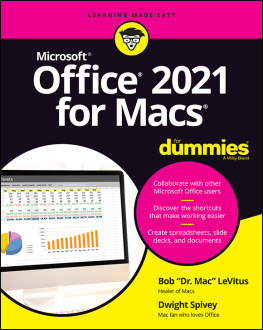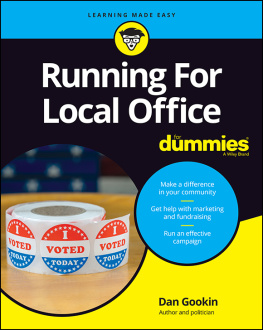
Marketing and Leasing:
OFFICE BUILDINGS

IREM Content and
Curriculum Development:
Rebecca Niday

2015 by the Institute of
Real Estate Management of the NATIONAL ASSOCIATION OF REALTORS
All rights reserved. Published 2015
Printed in the United States of America
10 Digit: 1-57203-227-8
13 Digit: 978-1-57203-227-9
Ebook ISBN: 978-1-57203-235-4
This book or any part thereof may not be reproduced, stored in a retrieval system, or transmitted, in any form or by any means, electronic, mechanical, photocopying, recording, or otherwise, without the prior written permission of the publisher. Inquiries should be directed to:
Publishing Department
Institute of Real Estate Management
430 North Michigan Avenue
Chicago, IL 606114090.
This publication is designed to provide accurate and authoritative information in regard to the subject matter covered. Forms or other documents included in this book are intended as samples only. Because of changing and varying state and local laws, competent professional advice should be sought prior to the use of any document, form, exhibit, or the like.
This publication is sold with the understanding that the publisher is not engaged in rendering legal, accounting, or any other professional service. If legal advice or other expert assistance is required, the services of a competent professional should be sought.
IREM logo, IREM, CERTIFIED PROPERTY MANAGER, CPM, the CPM key logo, ACCREDITED RESIDENTIAL MANAGER, ARM, the ARM torch logo, ACCREDITED MANAGEMENT ORGANIZATION, AMO, the AMO circle logo, Income/Expense Analysis, Expense Analysis, JPM and MPSA are registered marks of the Institute of Real Estate Management.
Library of Congress Cataloging-in-Publication Data
Marketing and leasing : office buildings. Third edition.
pages cm
Earlier editions published as Marketing and leasing of office space, written by Duane F. Roberts.
Includes bibliographical references and index.
ISBN 978-1-57203-227-9 (softcover) ISBN 1-57203-227-8 (softcover) 1. Office buildingsManagement. 2. Offices. 3. Real estate management. 4. Office leases. 5. Landlord and tenant. I. Roberts, Duane F. Marketing and leasing of office space. II. Institute of Real Estate Management.
HD1393.55.R63 2015
333.33870688dc23
2014046758
ACKNOWLEDGEMENTS

We would like to thank the following Review Team for taking time from their personal and professional schedules to provide content and to review this book. Their dedication and support of IREM are greatly appreciated!
REVIEW TEAM CHAIR
Stephen M. Cary, CPM
[Omaha, Nebraska]
REVIEW TEAM MEMBERS
Jacqueline Harris, CPM
[Los Angeles, California]
Sam Chanin, CPM
[Aliso Viejo, California]
INTRODUCTION

This book provides the information a property manager needs to successfully face the challenges of attracting and retaining office building tenants.
The following topics are covered:
- OFFICE MARKETS. Office building characteristics, economics of office buildings, impact of leasing on value, method of space measurement
- MARKET ASSESSMENT. Regional and neighborhood analysis, impact of various economic factors (e.g., occupancy, vacancy, and availability rates, supply and demand, absorption), comparison grids for establishing average market rent
- MARKETING AND LEASING STRATEGIES. Working with brokers, office building marketing tactics, tenant mix and placement, prospect qualification, office building lease provisions, lease negotiation and analysis
- TENANT RETENTION. Implementing retention strategies, resolving tenant complaints, lease expiration, and buy outs
CHAPTER 1

Understanding Office Buildings
The following is a typical timeline of an office building lease deal. The timeline below shows where we are within the process.
A real estate managers role in marketing and leasing has a direct impact on the value of an office building, and knowledge of office building characteristics and economic factors is critical for an effective plan. A property manager must be able to identify office building characteristics and economic factors that contribute to an effective market analysis.
Whats in this chapter:
- Office Building Characteristics
- Office Building Classifications and Types
- Lease Types
- The Economics of Office Buildings
- Method of Space Measurement
OFFICE BUILDING CHARACTERISTICS
The average American worker spends about eight hours a day at work. That roughly translates into 40 hours a week and 2,080 hours a year. Considering that many Americans work for 40 years, that calculates to about 83,200 hours at work over the course of a lifetime. There is no doubt that office buildings play an integral role in the lives of individual workers and the companies for which they work.
Savvy real estate managers recognize that attracting and retaining office building tenants is key to maximizing value and meeting the owners goals. It all begins with the target market. In order to understand the target market of an office building, it is necessary to review various characteristics of the office building property. In broad terms, the following characteristics define an office buildings position in the market:
- Building classification
- Building type
Throughout the rest of this chapter, well explore these characteristics in more detail.
OFFICE BUILDING CLASSIFICATIONS AND TYPES
Office buildings are categorized according to their location, age, size, condition, and amenities for comparison purposes. They are generally classified as Class A, Class B, or Class C. Class type can fluctuate and change, over time, with any office building.
Many factors contribute to an office buildings classification and target market. Two prevailing issues are:
For example, if an older building is potentially appealing but cannot be retrofitted for advanced office systems, the building class will decline. The office building must be able to accommodate current business needs to maximize its economic potential. The importance of different attributes will vary depending on the market and changes in the economy. Additional classification factors include:
Next page

















